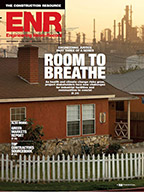With America’s infrastructure and IT infostructure in dire straits, and little if any federal government momentum to move money into critical investment, Top 20 Under 40 team members were clear that industry professionals need to rev up their own advocacy and creative solutions.
“[Companies] really aren’t showing how different ways of building ‘better, faster, cheaper’ can help fill that gap,” says Anita Woolley Nelson, who recently joined Skanska as chief strategy officer for building operations. “The industry has lobbied previously for certain things,” she says, and should speak out just as strongly on infrastructure finance needs.
Some already are making their voices heard.
“I’ve gone to Washington numerous times and met with my congresspeople,” says Barton Ross, president of Barton Ross & Partners LLC, a Chestertown, Md.-based architecture firm that specializes in historic preservation. “It doesn’t always make a difference but it’s important to get the message out.”
Having a unified industry message is critical, the professionals said, with broader and more frequent promotion of infrastructure project success stories. National industry groups such as the American Institute of Architects, American Society of Civil Engineers and Construction Management Association of America “should be responsible for helping drive the agenda,” says Nelson.
Team Infrastructure
Barton Ross
President, Barton Ross & Partners LLC.
Chestertown, Md.
Silky Wong
Lead Civil/Structural Engineer,
Dow, Houston
Anita Woolley Nelson
Chief Strategy Officer, Skanska USA Building Inc.
New York City
Mark Cochran
Chief Operating Officer, S. M. Wilson & Co.
St. Louis
Susan Stabler
Vice President/Div Mgr. Brasfield & Gorrie
Birmingham, Ala.
The team also weighed in on how project risk should be allocated among stakeholders as jobs get larger and more complex, with tougher cost and schedule drivers.
“There is a common misconception that contractors have large margins … at a moderate level of risk,” says Mark Cochran, COO of general contractor S.M. Wilson & Co. “Margins are very low and are obtained at a very high level of risk, especially in the current climate of labor shortages and rising costs.”
He cites alternate delivery and finance methods “that [allow] all project participants to share in benefits and risks of a project to lead to better outcomes,” pointing to integrated project delivery as one such approach for “a mutual understanding of risks and benefits.”
New demands on internet speed and functionality—and a host of known and unknown cybersecurity risks ahead—will require focused infostructure investment.
But the rising leaders, such as Skanska’s Nelson, are concerned that with technology moving so fast, the U.S. could face another infostructure rebuild in five years, rather than 50.
Ross noted that when high-speed internet construction in his town hit a multiyear delay, the technology was obsolete before work was done.
To confront growing cyber risks, “there needs to be more interdisciplinary cooperation” between data scientists and contractors, says Silky Wong, lead civil-structural engineer at Dow Chemical.
Her peers agree. “As we think about what to build and how to build it, we have to think about what could shut it down [and how to recover data], whether it’s a cyberattack or a natural disaster,” says Nelson. “People are thinking about it, but I don’t know if it’s their top priority yet.”
The industry faces similar challenges to determine return on investment on any given technology and the best bet on products with longevity.
“If people pay enough attention, there will be a way to understand what we need … and implement a plan that is executable,” says Wong.
The team proposed standardizing industry-focused technology and software to prepare for disrupters such as a recession. Susan Stabler, a Brasfield & Gorrie vice president, said firms must share lessons learned from the last event, since “the next one’s coming.”
Backstory
Barton Ross built an extensive American Flyer model train with his son, age 8.
Silky Wong runs half marathons with a Fluor Corp. mentor.
Anita Woolley Nelson dressed as her school’s mascot in high school.
Mark Cochran was named his company’s first-ever COO.
Susan Stabler started as a project manager; now she’s health-care division chief.






Post a comment to this article
Report Abusive Comment